What is assessed in circ - Study guides, Class notes & Summaries
Looking for the best study guides, study notes and summaries about What is assessed in circ? On this page you'll find 16 study documents about What is assessed in circ.
All 16 results
Sort by

-
TNCC Physical Assessments CORRECT ANSWER
- Exam (elaborations) • 7 pages • 2023
-
Available in package deal
-
- $9.49
- + learn more
TNCC Physical Assessments CORRECT ANSWER What is the Trauma Assessment Mnemonic? - CORRECT ANSWER-A = Airway with simultaneous cervical spine stabilization/immobilization B = Breathing C = Circulation D = Disability (neurologic status) E = Expose patient/Environmental Control F = Full set of VS/Focused Adjuncts/Facilitate Family Presence G = Give comfort measures H = History/Head-to-toe assessment I = Inspect posterior surfaces
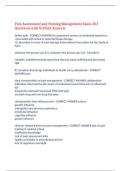
-
Pain Assessment and Nursing Management Exam 203 Questions with Verified Answers,100% CORRECT
- Exam (elaborations) • 27 pages • 2024
-
- $12.99
- + learn more
Pain Assessment and Nursing Management Exam 203 Questions with Verified Answers Define pain - CORRECT ANSWER An unpleasant sensory or emotional experience Associated with actual or potential tissue damage Or described in terms of such damage (International Association for the Study of Pain) whatever the person says it is, whenever the person says it is - McCaffery complex, multidimensional experience that can cause suffering and decreased QOL #1 symptom that brings individuals to...
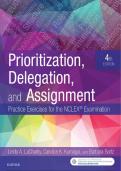
-
Prioritization, Delegation, and Assignment Practice Exercises for the NCLEX Exam
- Exam (elaborations) • 735 pages • 2023
-
Available in package deal
-
- $26.44
- + learn more
Questions 1. Which postoperative client is manifesting the most serious negative effect of inadequate pain management? 1. Demonstrates continuous use of call bell related to unsatisfied needs and discomfort 2. Develops venous thromboembolism related to immobility caused by pain and discomfort 3. Refuses to participate in physical therapy because of fear of pain caused by exercises 4. Feels depressed about loss of function and hopeless about getting relief from pain 2. A client with chronic...
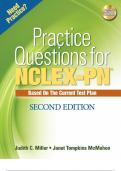
-
Prioritization, Delegation, and Assignment Practice Exercises for the NCLEX Exam
- Exam (elaborations) • 403 pages • 2023
-
Available in package deal
-
- $28.38
- + learn more
Questions 1. Which postoperative client is manifesting the most serious negative effect of inadequate pain management? 1. Demonstrates continuous use of call bell related to unsatisfied needs and discomfort 2. Develops venous thromboembolism related to immobility caused by pain and discomfort 3. Refuses to participate in physical therapy because of fear of pain caused by exercises 4. Feels depressed about loss of function and hopeless about getting relief from pain 2. A client with chronic...
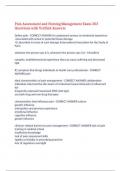
-
Pain Assessment and Nursing Management Exam 203 Questions with Verified Answers,100% CORRECT
- Exam (elaborations) • 27 pages • 2024
-
- $12.99
- + learn more
Pain Assessment and Nursing Management Exam 203 Questions with Verified Answers Define pain - CORRECT ANSWER An unpleasant sensory or emotional experience Associated with actual or potential tissue damage Or described in terms of such damage (International Association for the Study of Pain) whatever the person says it is, whenever the person says it is - McCaffery complex, multidimensional experience that can cause suffering and decreased QOL #1 symptom that brings individuals to...
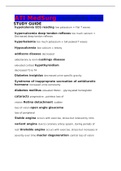
-
ATI MedSurg complete test
- Exam (elaborations) • 99 pages • 2022
-
- $9.99
- + learn more
hypokalemia ECG reading low potassium = Flat T waves hypercalcemia deep tendon reflexes too much calcium = Decreased deep tendon reflexes hyperkalemia too much potassium = tall peaked T waves Hypocalcemia low calcium = tetany addisons disease decreased aldosterone & renin cushings disease elevated cortisol hypothyroidism decreased T3 & T4 Diabetes insipidus decreased urine specific gravity Syndrome of inapproprate secreation of antidiuretic hormone increased urine osmolarity diabetes ...
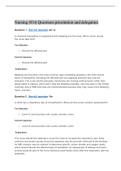
-
Nursing 4516 Questions prioritation and delegation |Latest update
- Exam (elaborations) • 19 pages • 2022
-
- $15.99
- + learn more
Nursing 4516 Questions prioritation and delegation |Latest update Nursing 4516 Questions prioritation and delegation Question 1 See full question 4m 1s A child with hemophilia is hospitalized with bleeding into the knee. Which action should the nurse take first? You Selected: • Elevate the affected part Correct response: • Elevate the affected part Explanation: Bleeding into the joint is the most common type of bleeding episode in the more severe forms of hemophilia...
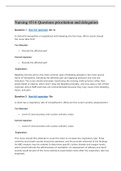
-
Nursing 4516 Questions prioritation and delegation |Latest update
- Exam (elaborations) • 19 pages • 2022
-
- $15.99
- + learn more
Nursing 4516 Questions prioritation and delegation |Latest update Nursing 4516 Questions prioritation and delegation Question 1 See full question 4m 1s A child with hemophilia is hospitalized with bleeding into the knee. Which action should the nurse take first? You Selected: • Elevate the affected part Correct response: • Elevate the affected part Explanation: Bleeding into the joint is the most common type of bleeding episode in the more severe forms of hemophilia...
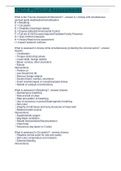
-
TNCC Physical Assessments
- Exam (elaborations) • 6 pages • 2022
-
Available in package deal
-
- $10.49
- + learn more
What is the Trauma Assessment Mnemonic? A = Airway with simultaneous cervical spine stabilization/immobilization B = Breathing C = Circulation D = Disability (neurologic status) E = Expose patient/Environmental Control F = Full set of VS/Focused Adjuncts/Facilitate Family Presence G = Give comfort measures H = History/Head-to-toe assessment I = Inspect posterior surfaces What is assessed in Airway while simultaneously protecting the cervical spine? Assess: - Vocalization - Tongu...
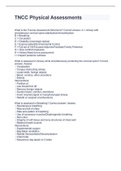
-
TNCC Physical Assessments
- Exam (elaborations) • 6 pages • 2022
- Available in package deal
-
- $10.39
- + learn more
TNCC Physical Assessments

How did he do that? By selling his study resources on Stuvia. Try it yourself! Discover all about earning on Stuvia


